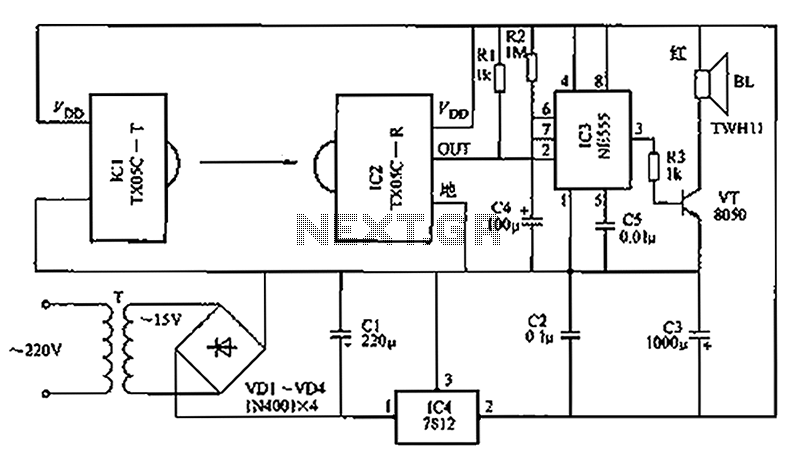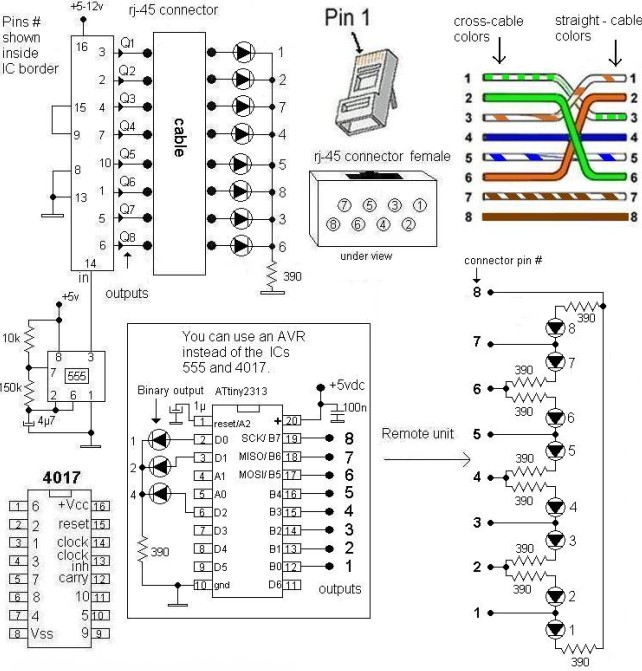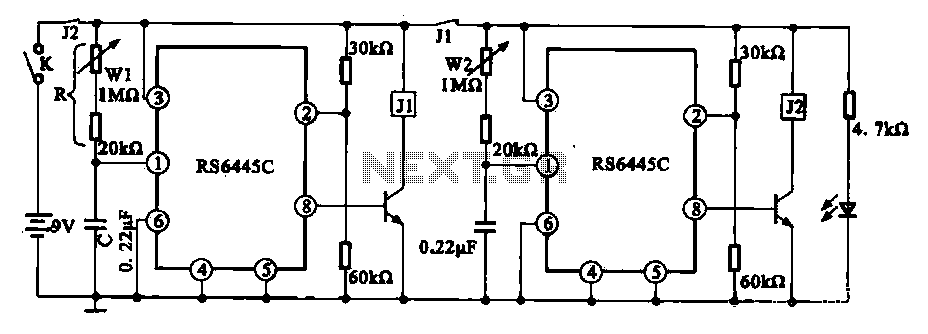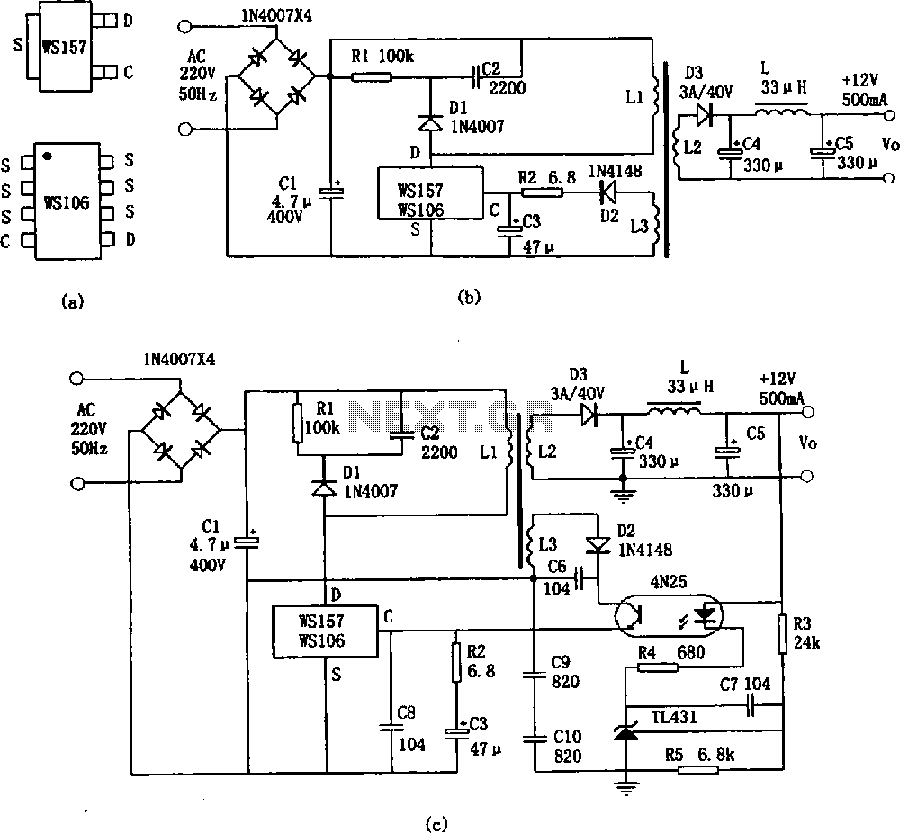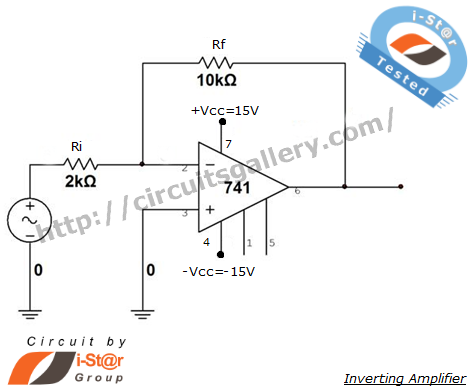
Dynamic to electret microphone circuit
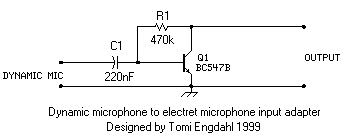
This is a simple microphone preamplifier circuit which you can use between your dynamic microphone and any equipment designed to work with an electret microphone (2 wire connection to electret capsule). This amplifier amplifies the low level signal to the levels used by electret microphone input and uses the power from the device. More: Circuit which works as a preamplifier which allows you to replace an electret microphone with a dynamic microphone. Circuit protection: No special protection circuits used. Circuit complexity: Very simple one transistor circuit.
The described microphone preamplifier circuit is designed to interface a dynamic microphone with devices that typically accept signals from electret microphones. The circuit primarily consists of a single transistor, which serves as the amplification element. The dynamic microphone generates a low-level audio signal, which is then fed into the base of the transistor.
The transistor is configured in a common-emitter arrangement, providing voltage gain to the input signal. The gain can be adjusted by selecting appropriate resistor values in the circuit, particularly the collector and emitter resistors. The power supply for the circuit is typically derived from the device to which it is connected, often utilizing a standard voltage level, such as 5V or 9V, depending on the application requirements.
Since this circuit does not incorporate any specialized protection mechanisms, care must be taken to ensure that the circuit is not exposed to excessive voltage levels or reverse polarity, as this could damage the transistor or the microphone. The simplicity of the design makes it suitable for various applications where space and component count are critical, such as handheld recording devices or compact audio interfaces.
Overall, this microphone preamplifier circuit effectively allows for the use of dynamic microphones in systems designed for electret microphones, enhancing versatility in audio capture while maintaining a straightforward design approach.This is a simple microphone preamplifier circuit which you can use between your dynamic microphone and any equipment designed to work with an electret microhone (2 wire connection to electret capsule). This amplifier amplifies the low level signal to the levels used by electret microphone input and uses the power from the device.
Circuit which works as an preamplifier which allows you to replace an electret microphone with a dynamic microphone. Circuit protection: No special protection circuits used Circuit complexity: Very simple one transistor circuit Circuit performance:
🔗 External reference
The described microphone preamplifier circuit is designed to interface a dynamic microphone with devices that typically accept signals from electret microphones. The circuit primarily consists of a single transistor, which serves as the amplification element. The dynamic microphone generates a low-level audio signal, which is then fed into the base of the transistor.
The transistor is configured in a common-emitter arrangement, providing voltage gain to the input signal. The gain can be adjusted by selecting appropriate resistor values in the circuit, particularly the collector and emitter resistors. The power supply for the circuit is typically derived from the device to which it is connected, often utilizing a standard voltage level, such as 5V or 9V, depending on the application requirements.
Since this circuit does not incorporate any specialized protection mechanisms, care must be taken to ensure that the circuit is not exposed to excessive voltage levels or reverse polarity, as this could damage the transistor or the microphone. The simplicity of the design makes it suitable for various applications where space and component count are critical, such as handheld recording devices or compact audio interfaces.
Overall, this microphone preamplifier circuit effectively allows for the use of dynamic microphones in systems designed for electret microphones, enhancing versatility in audio capture while maintaining a straightforward design approach.This is a simple microphone preamplifier circuit which you can use between your dynamic microphone and any equipment designed to work with an electret microhone (2 wire connection to electret capsule). This amplifier amplifies the low level signal to the levels used by electret microphone input and uses the power from the device.
Circuit which works as an preamplifier which allows you to replace an electret microphone with a dynamic microphone. Circuit protection: No special protection circuits used Circuit complexity: Very simple one transistor circuit Circuit performance:
🔗 External reference
